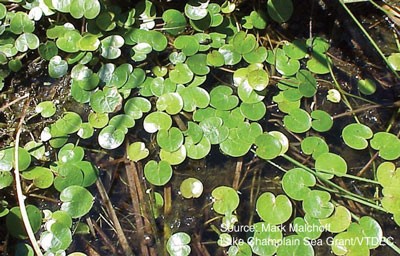Community News

European Frog-Bit
Description: European frog-bit is a small free-floating water plant. Its small kidney or heart shaped leaves (1.5 to 6.5 cm long) are not anchored to the bottom sediments.
Habitat: European frog-bit (or frog’s bit) is found in the floating-leaved plant community. It is a free-floating plant that thrives in open marsh habitat and quiet backwaters, forming thick floating colonies.
Annual Cycle: European frog-bit is an water perennial that grows primarily by vegetative means. Mature plants send out multiple offspring on trailing runners. Winter buds form during the summer, and fall to the bottom as plants begin to decay at the end of the growing season. In the spring the buds break dormancy, bob to the water surface, and sprout new growth. Flowers, followed by fruits, occur during the summer.
Origin and U.S. Range: European frog-bit is native to Europe. It is not native to New England and is considered invasive to this area. Nearby populations occur in Vermont and New York.
Look a likes: May be confused with fragrant water-lily, little floating heart, spatterdock, and water shield.
